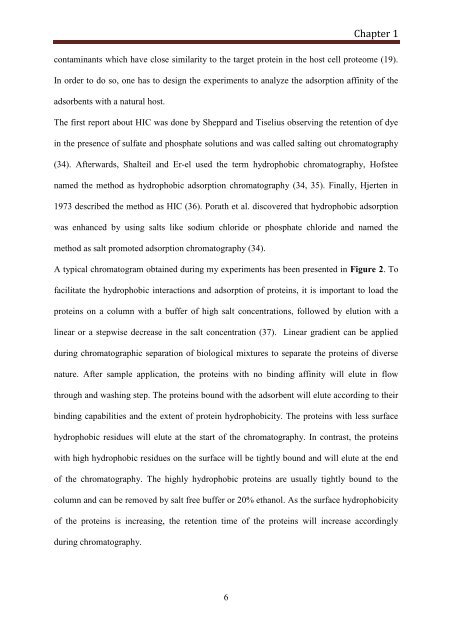Thesis final - after defense-7 - Jacobs University
Thesis final - after defense-7 - Jacobs University
Thesis final - after defense-7 - Jacobs University
Create successful ePaper yourself
Turn your PDF publications into a flip-book with our unique Google optimized e-Paper software.
Chapter 1<br />
contaminants which have close similarity to the target protein in the host cell proteome (19).<br />
In order to do so, one has to design the experiments to analyze the adsorption affinity of the<br />
adsorbents with a natural host.<br />
The first report about HIC was done by Sheppard and Tiselius observing the retention of dye<br />
in the presence of sulfate and phosphate solutions and was called salting out chromatography<br />
(34). Afterwards, Shalteil and Er-el used the term hydrophobic chromatography, Hofstee<br />
named the method as hydrophobic adsorption chromatography (34, 35). Finally, Hjerten in<br />
1973 described the method as HIC (36). Porath et al. discovered that hydrophobic adsorption<br />
was enhanced by using salts like sodium chloride or phosphate chloride and named the<br />
method as salt promoted adsorption chromatography (34).<br />
A typical chromatogram obtained during my experiments has been presented in Figure 2. To<br />
facilitate the hydrophobic interactions and adsorption of proteins, it is important to load the<br />
proteins on a column with a buffer of high salt concentrations, followed by elution with a<br />
linear or a stepwise decrease in the salt concentration (37). Linear gradient can be applied<br />
during chromatographic separation of biological mixtures to separate the proteins of diverse<br />
nature. After sample application, the proteins with no binding affinity will elute in flow<br />
through and washing step. The proteins bound with the adsorbent will elute according to their<br />
binding capabilities and the extent of protein hydrophobicity. The proteins with less surface<br />
hydrophobic residues will elute at the start of the chromatography. In contrast, the proteins<br />
with high hydrophobic residues on the surface will be tightly bound and will elute at the end<br />
of the chromatography. The highly hydrophobic proteins are usually tightly bound to the<br />
column and can be removed by salt free buffer or 20% ethanol. As the surface hydrophobicity<br />
of the proteins is increasing, the retention time of the proteins will increase accordingly<br />
during chromatography.<br />
6

















